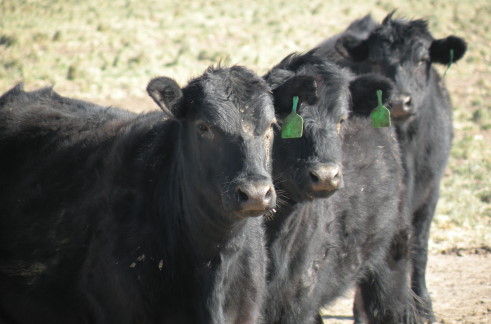
Agricultural News
Understanding and Avoiding Heat Stress in Cattle
Mon, 07 Jun 2010 8:11:26 CDT
 Understanding and avoiding heat stress in cattle can be a valuable management tool for summertime in Oklahoma. According to the 1997 Oklahoma Climatological Survey most areas of Oklahoma have 10 or more days each year above 100 degrees and 70 or more days with high temperatures above 90 degrees Fahrenheit. This means that most cow calf operations will be working cattle on days when heat stress to cattle is possible. Cattle have an upper critical temperature approximately 20 degrees cooler than humans. When humans are uncomfortable at 80 degrees and feel hot at 90 degrees, cattle may well be in the danger zone for extreme heat stress. Humidity is an additional stressor that intensifies the heat by making body heat dissipation more difficult.
Understanding and avoiding heat stress in cattle can be a valuable management tool for summertime in Oklahoma. According to the 1997 Oklahoma Climatological Survey most areas of Oklahoma have 10 or more days each year above 100 degrees and 70 or more days with high temperatures above 90 degrees Fahrenheit. This means that most cow calf operations will be working cattle on days when heat stress to cattle is possible. Cattle have an upper critical temperature approximately 20 degrees cooler than humans. When humans are uncomfortable at 80 degrees and feel hot at 90 degrees, cattle may well be in the danger zone for extreme heat stress. Humidity is an additional stressor that intensifies the heat by making body heat dissipation more difficult.
Over heating is sporadically encountered in cattle, but is really a rare problem. High humidity contributes to the likelihood of heat stroke or prostration because water evaporation from the oral and nasal cavities is decreased, in spite of rapid panting. At an environmental temperature of about 88 degrees, heat dissipation mechanisms such as sweating and evaporative cooling must take place to prevent a rise in body temperature. Sweat gland activity in cattle increases as the temperature goes above the thermoneutral zone. Panting is an important heat regulatory device in cattle.
The signs of overheating may develop suddenly and depend upon the environmental conditions and the health of the cattle exposed to the heat. Panting often occurs at rectal temperatures at or above 104 degrees F, but may begin even at lower body temperatures. Some animals manifest restlessness, excitement, and spasms of certain muscles. However, other animals may be dull and depressed. A protruding tongue may be covered with saliva, and frothy mucus discharged at the nostrils. Rectal temperatures of overheated cattle have ranged as high as 107 to 115 degrees F.
Overheating in cattle can be prevented under most management conditions. Allowing animals access to cool water and mineral supplements is a must in very hot summer weather. Shade and free air circulation should be provided if at all possible. Avoid working cattle during very hot parts of the day. Very excitable cattle will be even more prone to heat stress if handled at high environmental temperatures. If animals are going to have limited access to water under stressful conditions such as shipping by truck or trailer, they should be allowed water prior to further stressful situations.
If weaning calls for cattle to be gathered and put through a working chute for immunizations, implanting, or other operations, then a few common sense rules should be followed.
1) During hot weather, cattle should be worked before 8:00 am, if possible. Certainly all cattle working must be complete by about 10:00 am. While it may seem to make sense to work cattle after sun down, they will need at least 6 hours of night cooling before enough heat is dissipated to cool down from an extremely hot day.
2) Cattle that must be handled during hot weather should spend less than 30 minutes in the working facility. Drylot pens and corrals loaded with cattle will have very little if any air movement. Cattle will gain heat constantly while they are in these areas. Therefore a time limit of one-half hour in the confined cattle working area should limit the heat gain and therefore the heat stress.
3) Make every effort to see that cool, fresh, water is available to cattle in close confined areas for any length of time. During hot weather conditions cattle will drink more than 1% of their body weight per hour. Producers need to be certain that the water supply lines are capable of keeping up with demand, if working cattle during hot weather.
WebReadyTM Powered by WireReady® NSI
Top Agricultural News
More Headlines...




















